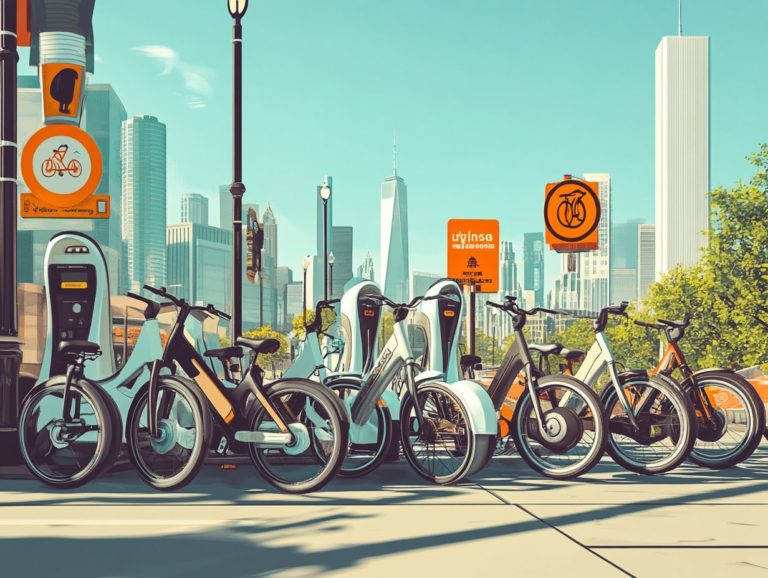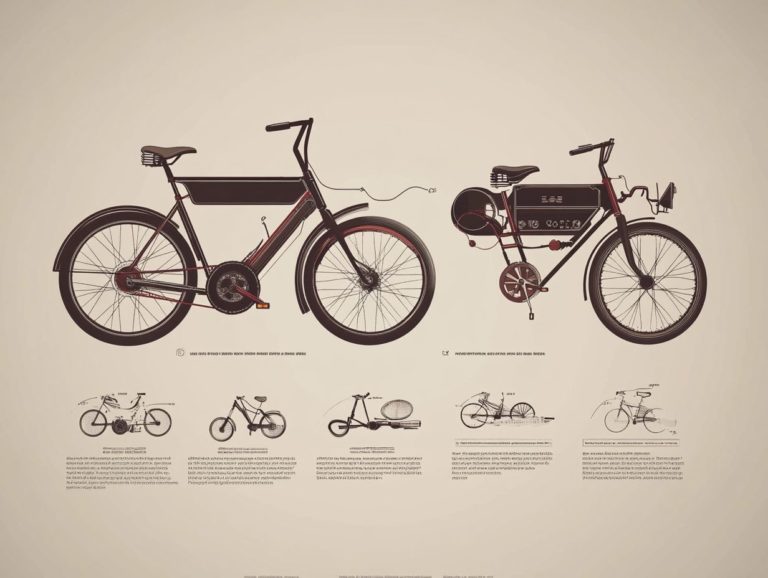What Are the Classifications of Electric Bicycles?
Electric bicycles, or e-bikes, are revolutionizing your commute, offering a perfect blend of convenience and eco-friendliness.
This overview explores electric bicycles, beginning with their definitions and purposes. It examines various types available from pedal assist models to throttle assist and speed pedelecs while shedding light on the legal classifications that dictate their use.
You ll gain insights on selecting the perfect e-bike tailored to your needs and uncover the numerous environmental and health benefits they provide.
Get ready to dive into the thrilling world of e-biking!
Contents
Key Takeaways:
- There are three main types of electric bikes: pedal assist, throttle assist, and speed pedelec. Each type offers different levels of assistance and is subject to specific regulations.
- When choosing an electric bike, consider factors like intended use, riding styles, and legal guidelines. This will help determine the appropriate type for you.
- Using electric bikes not only benefits the environment but promotes physical activity and improves overall health. They are a practical and eco-friendly alternative to traditional transportation.
Why Electric Bicycles Are the Future of Travel
Electric bicycles, or e-bikes, are transforming transportation, providing an enjoyable and eco-friendly alternative to traditional biking and driving.
These remarkable machines are equipped with electric motors and rechargeable batteries that assist you, adapting to your riding style, whether you’re leisurely cruising or commuting. For those interested in exploring different options, check out the electric bicycle types, as there is a wide range of models available, including popular brands like Pedego, e-bikes cater to various preferences and needs.
The National Park Service and numerous local regulations are embracing electric bicycles, recognizing their potential for zero-emission travel and promoting sustainable transportation methods.
Definition and Purpose
Electric bicycles, or e-bikes, are equipped with an electric motor that enhances your ride through pedal assist or throttle acceleration, elevating your overall cycling experience.
This innovative mode of transport combines the classic mechanics of cycling with modern technology, allowing you to cover longer distances with less effort. With pedal assist, you enjoy an automatic boost that responds to your pedaling, creating a smooth and natural riding sensation. The throttle method provides an instant burst of power, perfect for tackling steep hills or quick sprints.
E-bikes cater to a diverse range of riders, making commuting enjoyable and leisurely rides more delightful. Features like adjustable assistance levels, integrated lights, and a system that helps recharge the battery while you ride turn everyday travel into an exhilarating journey. For those interested in exploring different options, learning about the most popular types of electric bicycles can be an appealing choice for those who are environmentally conscious and eager to enhance their cycling experiences.
Types of Electric Bicycles
Electric bicycles fall into three primary classes, each designed with specific functionality and riding styles in mind: Class 1, Class 2, and Class 3. Each class presents unique features and experiences tailored to the diverse needs of riders.
Class 1: Pedal Assist
Class 1 electric bikes feature pedal assist technology, meaning the electric motor activates only when you start pedaling. This offers a wonderfully natural riding experience, allowing you to reach a maximum speed of 20 mph effortlessly.
This aspect preserves the authenticity of traditional cycling while enhancing speed and efficiency, making these bikes attractive for both casual riders and fitness enthusiasts. To better understand the options available, check out the differences between e-bike models. You’ll appreciate the seamless transition between your pedaling and motor assistance, especially when tackling varied terrains like hills or covering long distances.
With different riding styles in mind, many riders feel more in control and connected to their bike, turning each ride into a more enjoyable and less strenuous experience. This model is perfect for leisurely excursions and daily commutes, encouraging an active lifestyle while minimizing fatigue along the way.
Explore the world of electric bikes today and enjoy a healthier, greener commute!
Class 2: Throttle Assist
Class 2 electric bikes come equipped with throttle assist, allowing you to engage the motor’s power without pedaling. This makes them the perfect choice for a relaxed riding experience, especially for throttle-only riding.
This feature appeals to casual cyclists. It also helps those with varying fitness levels or mobility challenges.
With a maximum speed capability of up to 20 miles per hour, these bikes offer an efficient means of transportation for urban commuting or leisurely rides in the park.
Keep in mind that local laws may regulate their use, often designating specific paths or trails where these bikes can be legally operated. Such regulations ensure safety for both cyclists and pedestrians, fostering harmonious coexistence in shared spaces.
Class 3: Speed Pedelec
Class 3 electric bikes, often referred to as speed pedelecs, provide a thrilling riding experience with pedal assist, allowing you to reach speeds of up to 28 mph.
This remarkable speed makes them an exceptional choice for those seeking an efficient transportation option, especially urban commuters eager to cut down on travel time while enjoying the fresh air.
As a recreational rider, you ll relish the excitement and versatility that higher speeds offer, enabling quicker outings and an extended range on your favorite trails.
Remember, Class 3 e-bikes have different regulations compared to Class 1 and Class 2. It s important to know these rules to enjoy your ride safely!
Legal Classifications of Electric Bicycles
The legal classifications of electric bicycles are shaped by a blend of federal regulations and state laws, which delineate the parameters for each class.
These regulations establish guidelines for their use on public roads and bike paths, ensuring that you navigate the rules with clarity and confidence.
Federal and State Regulations
Federal regulations surrounding electric bicycles establish a foundational framework, while state regulations fine-tune the definitions and usage of e-bikes across various classes in the United States.
These federal guidelines categorize e-bikes into distinct classes based on their speed and the presence of pedal assistance. For a deeper insight, check out this understanding of different types of electric bicycles. Individual states have the discretion to implement their own rules, creating a mosaic of local laws that dictate where and how you can ride your electric bike.
Some states enforce age restrictions, requiring riders to be a certain age to legally operate these vehicles. Additionally, safety requirements like helmet laws or equipment standards can vary, influencing your riding experience and the compliance landscape for e-bike enthusiasts. It’s also important to understand the electric bicycle types available to ensure you choose the right one for your needs.
Choosing the Right Electric Bicycle Class
Choosing the right class of electric bicycle requires thoughtful consideration of your riding preferences whether you re commuting, enjoying leisurely rides, or pursuing high-performance experiences.
It s essential to consider local regulations and identify specific e-bike models that align with your needs.
Factors to Consider
When selecting an electric bicycle, consider factors such as your riding style, local laws, and the specific regulations that govern e-bikes in your area.
These elements significantly shape your overall riding experience. Your preferences, whether you enjoy leisurely rides through picturesque parks or face the daily grind of urban commutes, will heavily influence the type of e-bike and its features that best suit you. It’s also important to understand the laws for electric bicycles in your area before making a decision.
The riding environment plays a critical role. Whether you’re navigating hilly terrain, cruising along flat pathways, or weaving through bustling city streets can determine the motor power and battery life you’ll need, as well as your understanding of the legal classifications of electric bikes.
Being aware of local laws regarding speed limits, helmet requirements, and designated e-bike zones can help you avoid potential legal headaches, ensuring a smooth ride that harmonizes with community regulations. For a deeper understanding, check out this electric bicycle classification guide.
Benefits of Using Electric Bicycles
The advantages of using electric bicycles, including low-speed electric bicycles, extend far beyond convenience. They offer environmental benefits and health improvements that positively impact individuals and communities.
Environmental and Health Benefits
Electric bicycles provide a compelling way to positively impact the environment by reducing carbon emissions and promoting sustainable transportation. They also enhance your well-being by encouraging regular physical activity.
These two-wheeled marvels not only improve your daily commute; they play a crucial role in addressing urban pollution and traffic congestion. If you’re considering one, it’s important to know that there are different classes of electric bicycles available, which can help you choose the right option for your needs. Riding an electric bicycle significantly reduces your reliance on fossil fuels, fostering cleaner air and a more sustainable environment.
The simple act of pedaling, supported by an electric motor, keeps you active and enhances your cardiovascular health and overall fitness. This blend of eco-friendliness and personal wellness emphasizes the allure of electric bicycles as a progressive solution for urban mobility.
Experience the thrill of riding an electric bicycle today! To learn more about the different models, check out electric bicycle types: the basics explained.
Frequently Asked Questions
What do the classifications mean for electric bicycles?
- Class 1: Pedal-assist bicycles that provide assistance while the rider is pedaling, reaching speeds up to 20 mph.
- Class 2: Throttle-assist bicycles that can propel the bike up to 20 mph without the rider pedaling.
- Class 3: Speed pedal-assist bicycles that reach speeds up to 28 mph and require the rider to pedal to activate the motor.
Do electric bicycles require a license or registration?
In most states, Class 1 and Class 2 electric bicycles do not require a license or registration. However, some states may require a license or registration for Class 3 electric bicycles.
Are there any age restrictions for riding an electric bicycle?
Age restrictions for riding an electric bicycle vary by state. In some states, riders must be at least 16 years old to ride a Class 3 electric bicycle, while others have no restrictions for any class.



